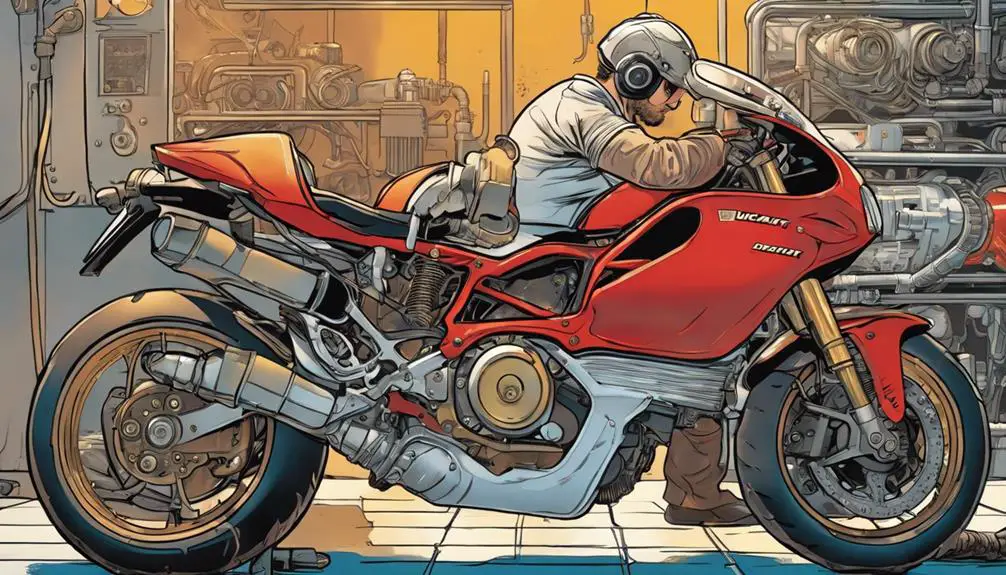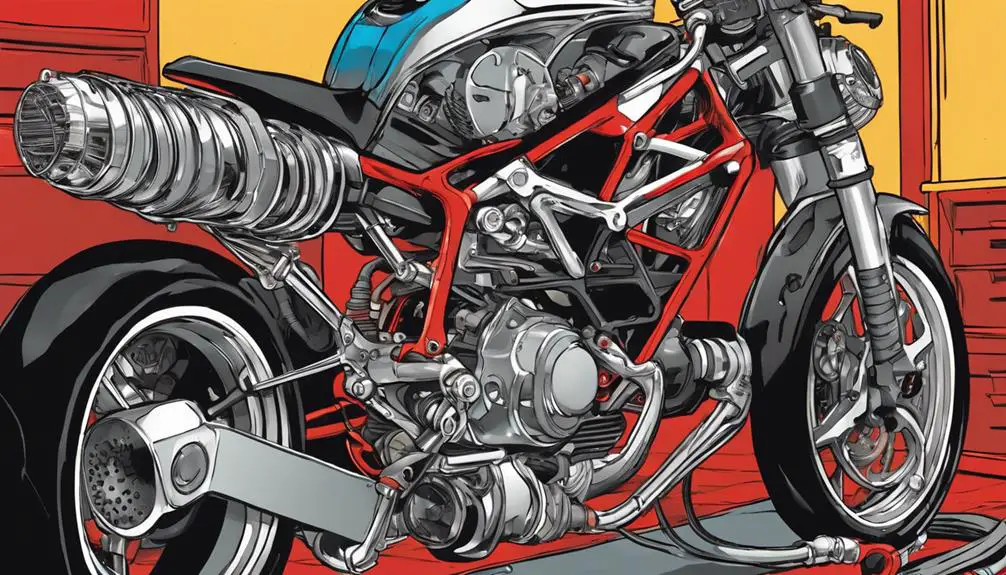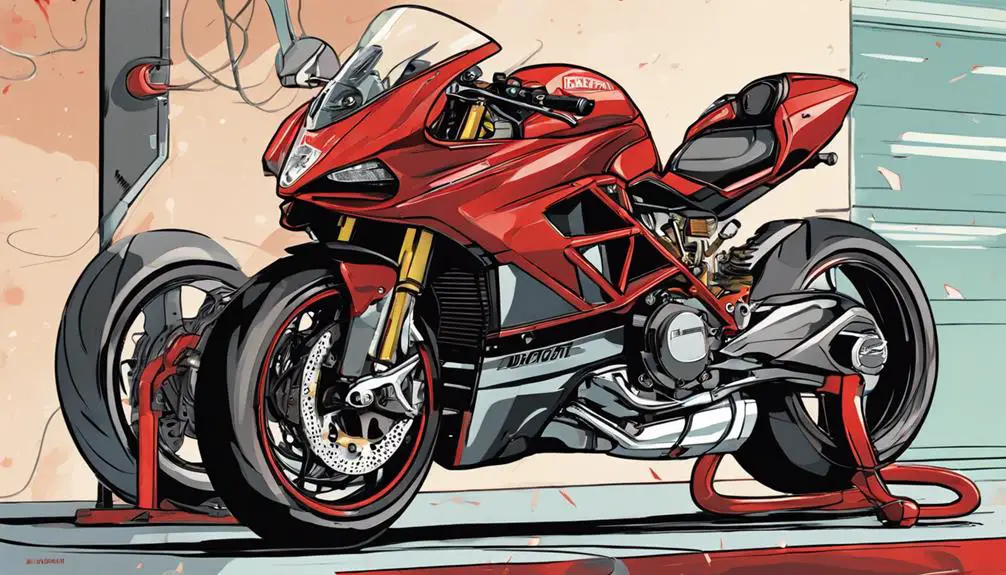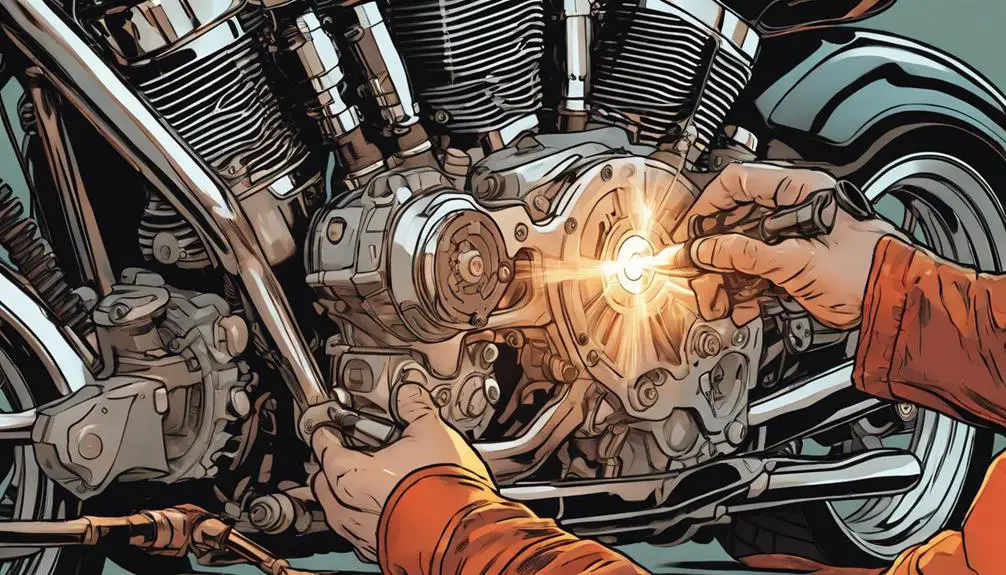Like a phoenix rising from the ashes, your Ducati bike deserves to perform at its peak without succumbing to overheating issues. You might find that a few key maintenance practices can make all the difference in keeping your engine cool and efficient. From monitoring fluid levels to enhancing airflow, there are several strategies you can employ. But what happens when these solutions aren't enough? Understanding the underlying causes of overheating could lead you to unexpected revelations about your ride.
Key Takeaways
- Regularly check and maintain coolant levels to prevent engine overheating and ensure optimal performance.
- Upgrade cooling systems, such as radiators and thermostats, for better heat dissipation during intense rides.
- Enhance airflow by cleaning air filters and radiators to improve cooling efficiency.
- Monitor engine temperature using gauges and diagnostic tools to identify overheating issues promptly.
Understanding Overheating Causes

Overheating in Ducati bikes can stem from several factors, including inadequate coolant levels, a malfunctioning thermostat, or blocked airflow.
When you ride, the engine generates heat, and without proper coolant, that heat can build up rapidly. Make it a priority to check your coolant levels regularly; even a small drop can lead to big problems.
A malfunctioning thermostat can also trap heat in your engine, preventing it from cooling down as it should. If you notice your bike's temperature gauge climbing higher than normal, it might be time to inspect this vital component.
Don't overlook the importance of airflow either. Blocked air intakes or a dirty radiator can restrict the cooling process, causing your bike to overheat. Confirm that your bike's ventilation systems are clear, allowing that sweet liberation of air to flow freely.
Understanding these causes empowers you to take control of your biking experience. By staying vigilant and addressing these issues proactively, you can preserve the performance and longevity of your Ducati.
Freedom on the road starts with knowing your machine inside and out.
Regular Maintenance Practices
Regular maintenance is essential to keep your Ducati running smoothly and prevent potential overheating issues. By prioritizing routine checks, you empower yourself to enjoy the ride without fear of breakdowns.
Start by checking the coolant levels regularly; low coolant can lead to overheating. Make it a habit to inspect the coolant hoses for any leaks or wear, ensuring they're in prime condition.
Next, keep your air filter clean. A clogged filter restricts airflow, causing your engine to work harder, which can lead to overheating. Replace it as needed to maintain peak performance.
Don't forget to monitor the oil levels and change the oil regularly. Fresh oil reduces friction and helps in regulating engine temperature.
Another key aspect is the radiator. Make sure it's free from debris, and clean it if necessary. A clean radiator allows for better heat dissipation.
Upgrading Cooling Systems

Upgrading your Ducati's cooling system can greatly enhance its performance and reliability, especially during long rides or in hot weather. When you take your bike to the open road, you want to feel the freedom of the ride without worrying about overheating. Investing in a better cooling system guarantees you can push your limits without compromise.
Consider these key upgrades:
- High-Performance Radiator: A larger radiator can dissipate heat more effectively, keeping your engine cool even under stress.
- Upgraded Thermostat: A thermostat that opens at a lower temperature can help maintain ideal engine temperature faster.
- Oil Cooler: Adding an oil cooler helps regulate oil temperature, improving lubrication and overall engine performance.
Checking Fluid Levels
To guarantee your Ducati runs smoothly, it's crucial to frequently check the fluid levels, as low fluids can lead to overheating and other performance issues.
Start by inspecting your coolant level; it should sit within the recommended range. If it's low, top it up with the correct mix to maintain peak performance. Remember, your bike's cooling system relies heavily on this fluid to dissipate heat effectively.
Next, check your engine oil. Low oil levels can not only lead to overheating but also cause severe engine damage. Use the dipstick to verify it's at the right level, and don't hesitate to change it if it's dirty or old.
Brake fluid is another critical fluid to monitor. Not only does it keep your brakes functioning properly, but it can also affect your overall riding experience. Make sure it's clear and at the appropriate level.
Lastly, don't forget about the clutch fluid. A well-lubricated clutch contributes to a smooth ride.
Keeping these fluid levels in check empowers you to ride freely, knowing your Ducati is in top shape and ready to conquer the road.
Improving Airflow

To tackle overheating, you need to focus on improving airflow around your Ducati.
By enhancing radiator efficiency, optimizing fairing design, and upgrading the exhaust system, you can considerably boost cooling performance.
Let's break down these strategies to keep your bike running cool and efficiently.
Enhance Radiator Efficiency
Improving airflow around the radiator can greatly boost cooling performance in your Ducati bike, helping to prevent overheating during intense rides. To achieve this, consider these key enhancements that can liberate your bike's potential:
- Upgrade the Radiator: Opt for a high-performance radiator that offers greater surface area and better cooling capacity.
- Install a Fan: A powerful electric fan can improve airflow, especially during slow-moving traffic or idling.
- Adjust the Positioning: Verify your radiator is free from obstructions. Adjust any components that might be blocking airflow.
Optimize Fairing Design
Optimizing the fairing design on your Ducati can greatly enhance airflow, reducing the risk of overheating during your rides. You'll want to focus on the shape and placement of the fairings to guarantee that air flows smoothly around the engine and other critical components. By doing this, you help cool down the bike, allowing you to release its full potential without the fear of overheating.
Consider integrating venting solutions into the fairing design. These vents can direct hot air away from the engine and out of the bike, promoting better cooling. Additionally, using lighter materials for fairings can improve overall performance while also affecting how air interacts with your bike's surfaces.
Regularly check your fairing for any obstructions. Dust, debris, or even minor damages can disrupt airflow, leading to overheating. Keep it clean and well-maintained to guarantee peak performance.
Custom fairing modifications can also be an option for those truly seeking freedom on the road. With the right design tweaks, you can create a unique look while enhancing functionality. Ultimately, optimizing your Ducati's fairing design is a step towards a cooler ride and a more exhilarating experience.
Upgrade Exhaust System
Upgrading your exhaust system can greatly enhance airflow, further reducing the chances of overheating while improving your bike's overall performance. When you replace your stock exhaust with a high-performance option, you're not just boosting efficiency; you're also revealing the true spirit of your Ducati. A well-designed exhaust system allows for better gas flow, which means your engine can breathe more easily and operate at peak temperatures.
Here are some benefits you can expect from an upgraded exhaust:
- Increased horsepower: Experience a noticeable boost in power with improved exhaust flow.
- Enhanced sound: Enjoy a more aggressive and satisfying engine note that reflects your bike's personality.
- Weight reduction: Lighter materials can shed unnecessary pounds, improving handling and agility.
Monitoring Engine Temperature
Monitoring your Ducati's engine temperature is vital for preventing overheating.
You need to keep an eye on temperature gauges, utilize diagnostic tools, and perform regular maintenance checks.
Importance of Temperature Gauges
Temperature gauges play an essential role in helping you keep your Ducati's engine within safe operating limits. By monitoring the temperature, you can easily prevent overheating and avoid costly repairs. You're not just riding; you're liberating yourself from the worry of engine failure.
Here are some key benefits of having a functional temperature gauge:
- Immediate Feedback: You get real-time data, allowing you to make swift decisions if temperatures rise.
- Enhanced Performance: Maintaining ideal temperature helps your bike perform at its peak, giving you that thrilling ride you crave.
- Increased Longevity: Keeping the engine cool means less wear and tear, extending the life of your beloved machine.
Incorporating a reliable temperature gauge into your riding experience is a powerful step toward ensuring both your safety and your bike's efficiency. It's more than just a tool; it's your companion on the road, guiding you to push limits without crossing them.
Take command of your ride and let the gauge be your ally in the pursuit of liberation.
Utilizing Diagnostic Tools
Using diagnostic tools can greatly enhance your ability to monitor engine temperature, ensuring your Ducati runs smoothly and efficiently. These tools let you tap into real-time data, giving you a clear picture of your bike's performance. You don't have to rely solely on basic gauges; now you can access detailed information about temperature fluctuations, which helps you catch overheating issues before they escalate.
Invest in a reliable diagnostic scanner that can connect to your bike's onboard computer. This way, you can track engine temperature and other critical variables while you ride. If you notice any abnormal readings, you can take action immediately, whether that means pulling over to cool down or adjusting your riding style.
Additionally, many diagnostic tools come with mobile apps, allowing you to monitor your Ducati effortlessly from your smartphone. This freedom empowers you to ride with confidence, knowing you're in control of your bike's health.
Regular Maintenance Checks
Regular maintenance checks help you keep a close eye on your Ducati's engine temperature, guaranteeing it operates within safe limits. By monitoring this essential aspect, you can ride with confidence, knowing your bike is in ideal condition.
Embracing the freedom of the open road means taking care of your machine, so let's explore key tasks to perform during your maintenance checks:
- Check coolant levels: Low coolant can lead to overheating. Always verify it's topped up.
- Inspect the radiator: Look for any leaks or blockages that could impede cooling efficiency.
- Monitor oil quality: Good oil circulation is critical for engine temperature control. Change it regularly.
When to Seek Professional Help

If your Ducati bike shows signs of overheating despite your attempts to manage it, it's time to consult a professional mechanic. Don't let pride or uncertainty hold you back; seeking help can save you from costly repairs down the line.
If you've tried basic solutions like checking coolant levels, inspecting hoses, or ensuring airflow, and the problem persists, professional intervention is essential.
Pay attention to symptoms such as the temperature gauge spiking, steam rising from the engine, or unusual noises. These signs indicate that deeper issues might be at play.
A skilled mechanic can diagnose problems like a failing water pump, clogged radiator, or a malfunctioning thermostat—issues that you mightn't be equipped to handle on your own.
Frequently Asked Questions
Can Riding Style Affect My Ducati's Overheating Risk?
Absolutely, your riding style can impact your Ducati's overheating risk.
When you push the throttle hard, especially in stop-and-go traffic or during aggressive riding, the engine works harder and generates more heat.
Smooth, controlled acceleration and allowing your bike to cool down during breaks can help mitigate that risk.
You're in control of how you ride, so adjusting your style can keep your bike running cooler and enhance your overall experience.
Are There Specific Ducati Models More Prone to Overheating?
Yes, some Ducati models are more prone to overheating. For instance, bikes like the Panigale and Monster series can experience issues under certain conditions, especially in stop-and-go traffic or during aggressive riding.
You'll want to pay attention to the coolant levels and the ambient temperature while riding. Knowing your bike's specific quirks will help you stay ahead of potential problems and enjoy your ride without the constant worry of overheating.
How Do I Know if My Radiator Is Clogged?
To know if your radiator's clogged, start by checking your coolant levels; low levels can indicate a blockage.
Look for any strange smells or overheating during rides. You can also inspect the radiator for debris or dirt accumulation.
If you notice any visible signs of corrosion or leaks, it's time to take action.
Is It Safe to Ride My Ducati While It's Overheating?
Riding your Ducati while it's overheating isn't safe.
You risk serious engine damage that could lead to costly repairs or even a breakdown.
If you notice the temperature gauge climbing, it's best to pull over and let it cool down.
Ignoring the problem might feel liberating in the moment, but it could end up grounding you for longer.
Listen to your bike; it's telling you to take a break and address the issue.
What Aftermarket Parts Help Prevent Overheating in Ducati Bikes?
When it comes to aftermarket parts that help prevent overheating in your Ducati, consider high-performance radiators and upgraded fans. These components improve airflow and cooling efficiency.
You might also want to look into thermostat modifications and oil coolers, which can further enhance temperature regulation.
Upgrading your exhaust system can promote better airflow as well.
Conclusion
By staying on top of regular maintenance and making the necessary upgrades, you can keep your Ducati running cooler than an Arctic breeze.
Remember, monitoring your bike's temperature and ensuring proper airflow are essential steps in preventing overheating.
If you find yourself battling persistent heat issues, don't hesitate to call in the pros.
Your bike deserves the best care, and with the right approach, you can ride with confidence, knowing you've got overheating under control.